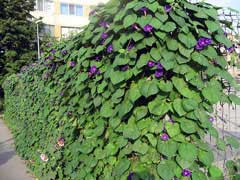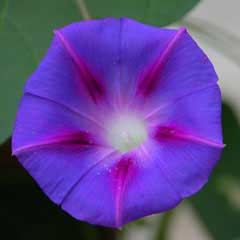 |
|
http://cs.wikipedia.org/wiki/Wikipedista:Dezidor |
 |
| http://en.wikipedia.org/wiki/User:Ram-Man |
Translate this page:
Summary
Bloom Color: Blue, Pink, Purple, Red, White. Main Bloom Time: Early fall, Late summer, Mid summer. Form: Spreading or horizontal, Variable spread.
Physical Characteristics

 Ipomoea purpurea is a ANNUAL CLIMBER growing to 2.5 m (8ft 2in) at a fast rate.
Ipomoea purpurea is a ANNUAL CLIMBER growing to 2.5 m (8ft 2in) at a fast rate.
See above for USDA hardiness. It is hardy to UK zone 7 and is not frost tender. It is in flower from July to September. The species is hermaphrodite (has both male and female organs).
Suitable for: light (sandy), medium (loamy) and heavy (clay) soils and prefers well-drained soil. Suitable pH: mildly acid, neutral and basic (mildly alkaline) soils. It cannot grow in the shade. It prefers moist soil.
UK Hardiness Map
US Hardiness Map
Synonyms
Pharbitis purpurea.
Plant Habitats
Cultivated Beds;
Edible Uses
References More on Edible Uses
Medicinal Uses
Plants For A Future can not take any responsibility for any adverse effects from the use of plants. Always seek advice from a professional before using a plant medicinally.
Anthelmintic Diuretic Hallucinogenic Laxative
The seed is anthelmintic, diuretic and laxative[176]. It is used in the treatment of oedema, oliguria, ascariasis and constipation[176]. The seed contains small quantities of the hallucinogen LSD[200, 219]. This has been used medicinally in the treatment of various mental disorders.
References More on Medicinal Uses
The Bookshop: Edible Plant Books
Our Latest books on Perennial Plants For Food Forests and Permaculture Gardens in paperback or digital formats.

Edible Tropical Plants
Food Forest Plants for Hotter Conditions: 250+ Plants For Tropical Food Forests & Permaculture Gardens.
More

Edible Temperate Plants
Plants for Your Food Forest: 500 Plants for Temperate Food Forests & Permaculture Gardens.
More

More Books
PFAF have eight books available in paperback and digital formats. Browse the shop for more information.
Shop Now
Other Uses
References More on Other Uses
Cultivation details
Landscape Uses:Arbor, Container, Specimen. Requires a fertile well-drained loam in a sunny position[200]. The plant is not very frost hardy, but it can be grown outdoors as a tender annual in temperate zones[200]. A very ornamental plant, there are several named varieties[200]. The flowers are blue, but they turn more pink later in the day[260]. Special Features:
Not North American native, Wetlands plant, Attractive flowers or blooms.
References Carbon Farming Information and Carbon Sequestration Information
Temperature Converter
Type a value in the Celsius field to convert the value to Fahrenheit:
Fahrenheit:
The PFAF Bookshop
Plants For A Future have a number of books available in paperback and digital form. Book titles include Edible Plants, Edible Perennials, Edible Trees,Edible Shrubs, Woodland Gardening, and Temperate Food Forest Plants. Our new book is Food Forest Plants For Hotter Conditions (Tropical and Sub-Tropical).
Shop Now
Plant Propagation
Pre-soak the seed for 12 hours in warm water, or scarify the seed, and sow in individual pots in a greenhouse in early spring. The seed usually germinates in 1 - 3 weeks at 22°c. Plants are extremely resentful of root disturbance, even when they are quite small, and should be potted up almost as soon as they germinate[219]. Grow them on fast in the greenhouse and plant them out into their permanent positions after the last expected frosts. Consider giving them some protection such as a cloche until they are growing away actively.
Other Names
If available other names are mentioned here
Native Range
Coming Soon
Weed Potential
Right plant wrong place. We are currently updating this section.
Please note that a plant may be invasive in one area but may not in your area so it's worth checking.
Conservation Status
IUCN Red List of Threatened Plants Status :

Growth: S = slow M = medium F = fast. Soil: L = light (sandy) M = medium H = heavy (clay). pH: A = acid N = neutral B = basic (alkaline). Shade: F = full shade S = semi-shade N = no shade. Moisture: D = dry M = Moist We = wet Wa = water.
Now available:
Food Forest Plants for Mediterranean Conditions
350+ Perennial Plants For Mediterranean and Drier Food Forests and Permaculture Gardens.
[Paperback and eBook]
This is the third in Plants For A Future's series of plant guides for food forests tailored to
specific climate zones. Following volumes on temperate and tropical ecosystems, this book focuses
on species suited to Mediterranean conditions—regions with hot, dry summers and cool, wet winters,
often facing the added challenge of climate change.
Read More
Expert comment
Author
(L.)Roth.
Botanical References
200
Links / References
For a list of references used on this page please go here
Readers comment